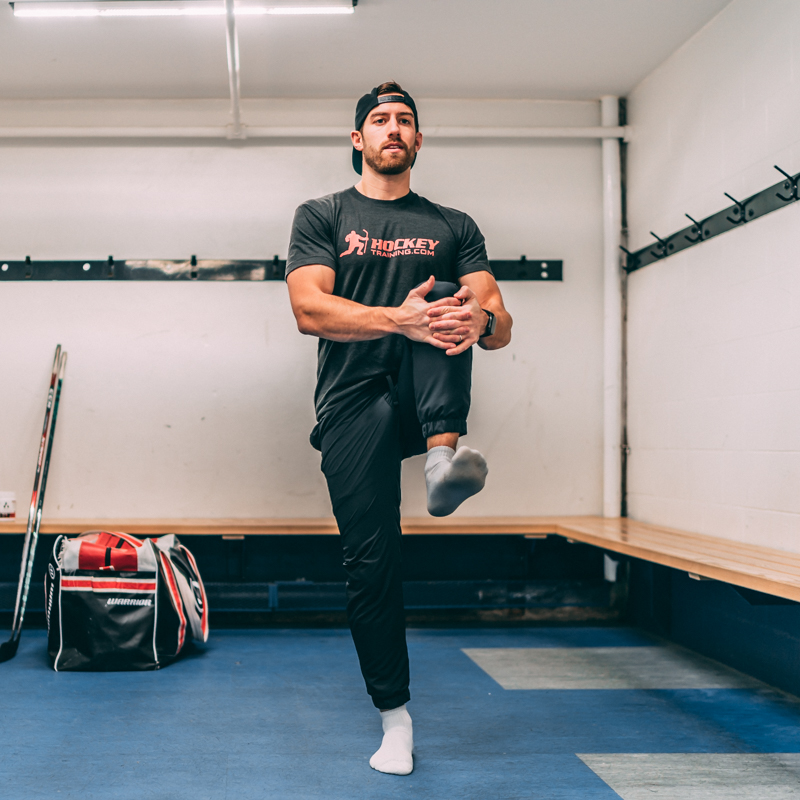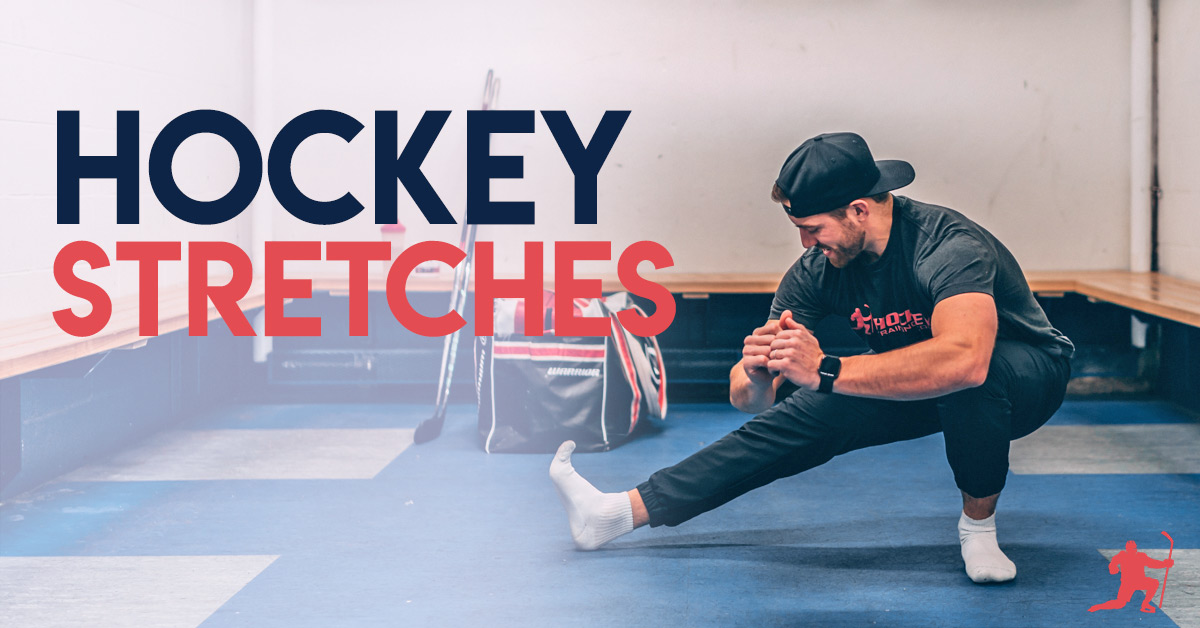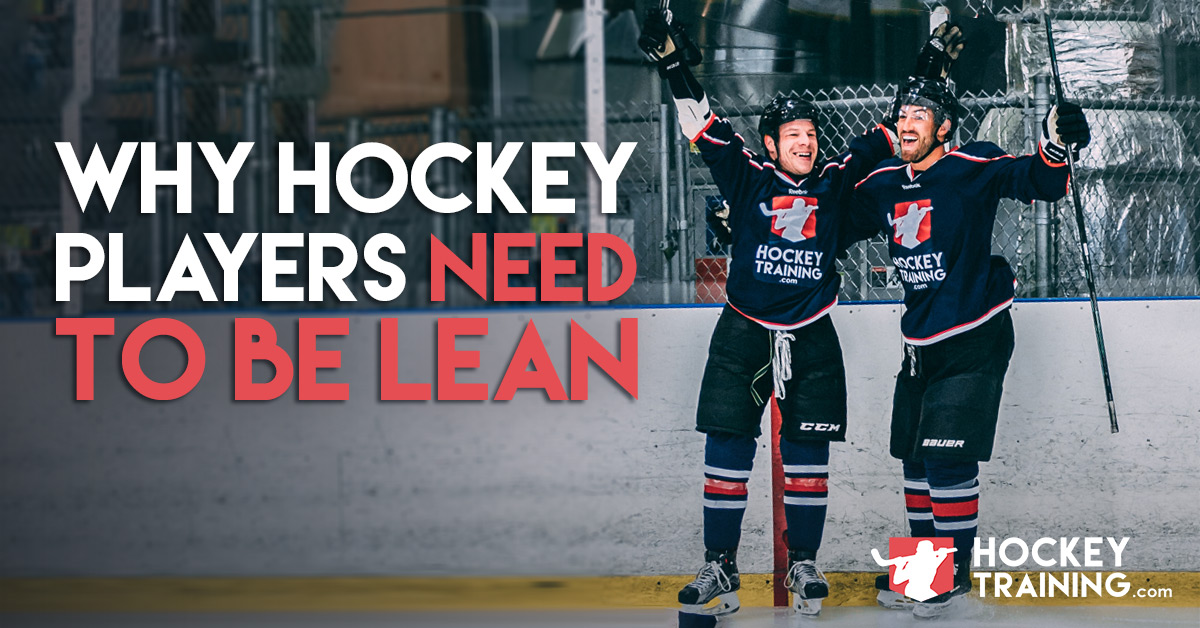Today’s article is going to cover how to increase your on-ice performance with a proper stretching routine and provide you with some of the best stretches for hockey players.
I’ll break it down in the following categories:
- Static Stretching For Hockey
- Dynamic Stretching For Hockey
- Hockey Mobility Training
- Best Hockey Stretches
Let’s dive into things…
In the game of hockey where an extra ounce of strength could knock you off the puck, or an extra half-second of time is the difference between you getting a clean shot off or not — it is my job to ensure your training is preparing you in every way possible to create an optimal result.
Every little detail matters if you want to be your best.
Oftentimes the same questions keep coming up:
“How do I improve flexibility?”
“Should I stretch before a game?”
“What stretches should I do before or after my workouts?”
For decades now we have heard from coaches and gym teachers that we should incorporate some light aerobic work prior to training and games in combination with some static stretching.
Although in recent times (as far as the sport-science research goes), these strategies are beginning to be questioned by more informed authorities.
This has led to confusion for hockey players.
Should we do a jog and static stretch for a warm-up? Or should we do a dynamic warm-up?

Well, let’s examine the applicable research in this area thoroughly so you can make the best decision for YOU.
Static Stretching
A static stretch is a deep, slow stretch, which is held in place for a long duration (usually 30 seconds – 2 minutes).
It was originally suggested that static stretching improves range of motion, increase your rate of recovery from exercise (decrease DOMS), enhances performance, and decreases your risk of injury.
Now with hundreds of studies that have been conducted on measuring performance in 1 rep max, running speed, reaction time, isometric torque production, jumping, and throwing — the results have been that most report that pre-exercise static stretching decreases human performance from a combination of both neurological and muscular factors inhibition factors.
It is also important to note that this performance decrease seems to have a linear relationship with how long you hold the stretch.
Meaning, the longer you hold it, the greater negative effect it can potentially have on your performance within that particular muscle group.
Here’s a quick breakdown on a meta-analysis performed in 2012 compiling 104 total studies on stretching and it’s effects of athletic performance:
• A very likely negative effect on performance from static stretching by reducing explosive muscular contraction
• A likely negative effect on maximal strength by decreasing Type ll fiber activation
• A likely negative, although inconclusive effect on muscular power output by disrupting certain neural pathways
(A. D. Kay and A. J. Blazevich, “Effect of acute static stretch on maximal muscle performance: a systematic review.,” Med. Sci. Sports Exerc., vol. 44, no. 1, pp. 154–64, Jan. 2012.)
In addition to the above, many of the studies deemed inconclusive have completely neutral performance effects, meaning, no better or no worse. Even with stretching, you’re still the same athlete.
Hockey requires you to be both strong and explosive, and the research suggests that static stretching before hockey will reduce both of these, which will create a net-decrease in hockey performance. Or, if you’re lucky, have a neutral effect — which is a complete waste of time.
But hold on a second.
Static stretching is not bad. That’s not what I am saying at all. We just don’t want to use it before hockey games or practices.
Static stretching must be kept in the post-workout or post-game window.
Static stretching has been shown to effectively improve range of motion, and not to mention it is very easy to learn for anybody at any level.
So the best-case scenario for a hockey player would be to follow these rules:
- Any and all static stretching should be performed on their own day, or, after games and workouts as part of a cool down strategy
- Use the static stretches on the body areas where hockey players so often create the same tightness’ (see my mobility article for more information on this).
For hockey players, this means working those static stretches in the:
- Hips
- Glutes
- Hamstrings
- Calf/Achilles Tendon
- Shoulders
Static Stretching Routine For Hockey Players
Here’s a static stretching routine to do after hockey games or your training sessions:
1. Groin frog stretch – Hold for 2 rounds, 15-30 secs
2. Seated piriformis stretch – Hold for 2 rounds, 15-30 secs
3. Seated glute stretch – Hold for 2 rounds, 15-30 secs
4. Hip flexor stretch, rear foot elevated – Hold for 2 rounds, 15-30 secs
5. Calf/Achilles tendon stretch on a stepper – Hold for 2 rounds, 15-30 secs
6. Anterior delt/pec stretch – Hold for 2 rounds, 15-30 secs
7. Posterior delt stretch – Hold for 2 rounds, 15-30 secs
8. Lying, internal rotator cuff stretch – Hold for 2 rounds, 15-30 secs
9. Lying quad stretch – Hold for 2 rounds, 15-30 secs
10. Seated hamstring stretch, reach for the toes – Hold for 2 rounds, 15-30 secs
NOTES:
• Best performed post-workout/game, or sometime in the evening hours after your on-ice session or workout.
• In addition to counting 15-30 secs, focus on taking deep diaphragmatic breaths.
• Do not overdo it. There is no trophy for who stretches the furthest.
• When trying to improve Range of Motion (ROM), perform this ideally 3-4x per week.
Dynamic Stretching
Dynamic stretching is a type of functionally based stretching exercise that incorporates more sport-specific movements to prepare the body for activity.
It places an emphasis on the movement requirements of the sport or activity rather than on individual muscles. (ie. jumping jacks vs hamstring stretch).
Dynamic stretching is the preferred type of stretching before activity (such as a hockey game).
Why?
Dynamic stretching improves range of motion in a joint more effectively than does static stretching while also being far more sport-specific than a static hold.
On top of that, the sport-specific movement and range of motion you go through with dynamic movements will also help increase the core temperature (something static stretching does not) and activate the central nervous system for proper recruitment of muscle fibers.
Lastly, unlike static stretching. dynamic stretching has not been shown in the research to have any negative effects on performance when done prior to exercise.
The combination of sport-specific movement, improved range of motion, improved performance, and no drawbacks make dynamic stretching a no-brainer for a solid option in the pre-game and pre-workout windows for hockey players.
How Long Should I Spend On My Dynamic Warm-Up?
The degree to which an athlete needs to stretch prior to game time is dependent on the sport.
As hockey players, we are right around the middle range compared to other sports.
We should be spending some time doing a dynamic warm-up before hockey (and training), but we don’t need to spend a crazy amount of time on it.
In most cases, a 5-15 minute warm-up will suffice.
Your Warm-Up Isn’t Only About Stretching
I also recommend athletes use this time in the dynamic stretching window before hockey games or training sessions to not only focus on technique and preparing the body physically, but also focus on getting in the zone mentally.
The warm-up is the time and the place to get your game face on and bring that killer, competitive attitude to the ice or into the gym.
Once the warm-up begins, it’s time to go — mentally and physically.
Hockey Dynamic Stretching Routine or Warm-Up
When assessing the movement mechanics, range of motion and stretch-shortening cycles for hockey, the following would be a great dynamic warm-up prior to your hockey:
Want a copy of this warm-up? You can get the Hockey Warm-up Cheat Sheet (FREE) here.
NOTES:
• Perform everything through a full range of motion.
• There is no trophy for who gets done first. Perform with good technique.
Creating Your Own Hockey Warm-Up
If you want to create your own dynamic stretching routine keep these in mind:
• Careful analysis of the game of hockey and the major movement patterns must be made
• The range of motion required for these movements should be assessed
• You need to have an exercise selection that best replicates these on-ice movements, not just from a purely “what it looks like” standpoint, but from a joint and range of motion perspective.
• You can perform the warm-up in repetitions (example jumping jacks x 10) or in distance covered (A-skips for 10 yds). Repetitions are usually easiest when performing by yourself, distance covered is usually best if working with the whole team.
• Each drill should start slow, and gradually increase the range of motion, speed, or repetitions as your body gets warmer.
Hockey Mobility Training
When we talk about increasing your mobility for hockey we usually don’t refer to it as “stretching”.
Mobility is the intersection of three different qualities:
- Flexibility
- Technique
- Strength
Mobility is much different than flexibility.
Flexibility is the ability of a muscle, or group of muscles, to passively lengthen through a range of motion. Stretching works on lengthening these tight muscles to improve their flexibility, whereas mobility involves much more than just tightness.
Mobility includes all elements that may limit a hockey athlete’s movement and performance such as their joint capsules, fascial tissue, range of motion dysfunctions, strength, neural damage, and plenty of others.
If you want to learn more about improving your mobility for hockey performance we have a complete Hockey Mobility Guide.
Here’s a sample mobility routine that was designed for hockey players:
Hockey Mobility Routine
1. Hang from pull up bar: 1 x 1-2 minutes
2. Arm circles: 1 x 10/direction
3. Rotational arm swing: 1 x 8/side
4. Hip circles: 1 x 10/direction
5. Zombie squat with reach through: 1 x 10
6. Scorpion kicks: 1 x 8/side
*Run through the circuit once without resting between exercises
Best Hockey Stretches
Although I’m going to pull from my years of experience and from my scouring of the scientific data on this topic to come up with my favorite stretches for hockey players, it’s important to point out that there is no “one best stretch” for absolutely everybody.
Generalities can be made for sure when it comes to hockey athletes as they consistently run into the same issues (due to the nature of the sport, it’s natural that there are common trends among athletes).
But, in some cases, you get those oddball players who have a mobility issue unlike any other athlete in the sport. And for those people, I really recommend you read this and also give this a go for a couple of months.
The Common Problems
Hockey players consistently have mobility issues within the:
- Hips + Lower Back
- Shoulders
- Calves + Achilles Tendon
- Hamstrings + Vastus Lateralis
Let’s have a look at each one and solve them one by one with the best stretches for hockey players.
Hips + Lower Back
If you look at a hockey player’s posture and movement throughout the game, he/she is bent over at the waist for pretty much the entire game.
During a face-off, taking a shot, skating, and even sitting on the bench. Players are in constant hip flexion (as opposed to extension, which would represent a straightening of the hips, or, “thrusting” motion).
This chronic hip flexion shortens and tightens the hip flexors, which can lead to a whole host of postural issues, including pain in the hips during movement, tightness in the hips, rounded shoulders, shoulder impingements, low back lordosis, and a forward lean in the neck.
My favorite exercises to alleviate pain and correct these tightnesses include:
Rear Foot Elevated Hip Flexor Stretch
Iron Cross
Deep Squat Hold With Alternating Reaches
Shoulders
When you’re standing in a relaxed position, your shoulders shouldn’t be pulled forward.
They should be at your side.
Also, in a relaxed position, they should be symmetrical in height.
One shoulder should not be higher or lower than the other. This type of tightness usually results in a forward head and neck lean as well (which ties into the same “root cause” reasoning as the hips/lower back).
Addressing shoulder tightness with hockey players is crucial for puck handling ability, shot power, and shot accuracy.
The internal and external rotator muscles work together to create a lot of this motion, and hockey players normally have a bigger issue with their external rotators. Specifically, they have issues with their scapula retractors (muscles that pull your shoulder blades into a “flat” position with the back, as opposed to having them stick out like bat wings).
My favorite exercises to alleviate pain and correct these tightnesses include:
Supine Shoulder Slides
Side Lying Windmills
Push Up ISO Hold With Hands Elevated
Calves + Achilles Tendon
The combined Achilles tendon and calf tightness pop up in many hockey players, and I believe it is mainly due to skating mechanics compared to running mechanics.
When running, you can fully extend the foot (pointing the toe downwards) in a straight-on movement.
Whereas in hockey, the foot is pointed slightly sideways, and there is much less overall extension, but still a ton of tension which can create tightness over time.
Tension plus no extension equals a lot of force that gets “stuck” in one joint and the surrounding area.
It also doesn’t help the issue that hockey players’ feet are completely stuck in a right angle for 6-8 months out of every year in the skating boot. When you’re locked in like that, in comparison to a running shoe which is very free movement, you’re bound to run into localized tightness.
My favorite exercises to alleviate pain and correct these tightnesses include:
Deep Squat Hold With Toes Elevated
Knee To Wall Ankle Mobilization
Lower Leg SMR
Hamstrings + Vastus Lateralis
The biceps femoris muscle of the hamstring in combination with the vastus lateralis muscle in the quadriceps both get tightened for the same reasons, they are prime movers in the force generated during a skating stride.
One of the biceps femoris main jobs is to point the foot outwards, which is the position hockey players’ feet are in whenever they are skating. The vastus lateralis is that big quad muscle on the outside of your thigh, its job to apply force down on the ice to propel you forward.
Both of these muscles get overused during hockey due to the volume of skating performed over the course of the competitive season, which leads to both of them slowly becoming tight as a rock.
For most hockey players, when it comes time for the offseason training to begin, I have noticed they have biceps femoris and vastus lateralis muscles that resemble steel rods. Way too tight to function properly.
My favorite exercises to alleviate pain and correct these tightnesses include:
Cossack Squats
Knee Hug Into Reverse Lunges
Rollover Into V-Sit
Improving Flexibility For Skating Performance
What makes players like McDavid and Crosby so special?
The way they move on the ice with ease and blow by opponents…
This leads to more scoring opportunities and has helped them both become one of the best players of all time…
One reason they move so fluidly on the ice is that they can open their hips while skating…
If you want to become a faster and better skater, you need to work on your hip tightnesses…
I highly recommend our Hockey Yoga videos to help you unlock your tight hips and release your true skating potential on the ice.
Frequently Asked Hockey Stretching Questions
Flexibility has a direct correlation to mobility, and hockey players need to be mobile to increase their stride length (skating speed), open up their hips for skating techniques (such as mohawk skating) and prevent injuries.
Dynamic stretching is best for before hockey games, practices, or training. Studies have shown that pre-exercise static stretching decreases human performance from a combination of both neurological and muscular factors inhibition factors.
Your dynamic stretching routine before playing hockey should last about 10-20 minutes.
Ideally 10-15 minutes before stepping out on the ice.
Final Thoughts
Stretching for hockey players falls into the same world as everything else in hockey training; it will only ever be as good as its application.
If you have these issues, working on them the right way (and at the right time) will allow you to become an all-around better hockey player.
I hope you found this hockey stretching guide helpful, and if you have any questions, please ask in the comment section below!










So I am extremely flexible as I stretch at least 5 times a week after hockey and other fitness. The butterfly stretch I can have knees on the ground and feel nothing so I lean forward the one where you want the right and when seated I can do relaxed and go further and still feel nothing. The one on your back while holding the knee up I can’t feel anything. With all this in mind I’m still not fast on the ice. What can else can I do to improve my speed. I am a lady player
Hey Kelly,
Mobility it only one component of speed, there is PLENTY more you can still work on to take your speed to the next level. Watch this video and identify your “weakest link in the chain” to figure out what’s best for you right now: https://www.youtube.com/watch?v=407A6hnB8wc&t=
After you watch that, check this out so you know exactly what to do with your weak link: http://www.hockeytraining.com/speed